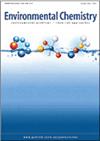A review of inorganic contaminants in Australian marine mammals, birds and turtles
IF 2.3
4区 环境科学与生态学
Q3 CHEMISTRY, ANALYTICAL
引用次数: 0
Abstract
Environmental context Metal concentrations can build up to potentially harmful levels in marine mammals as they are at the top of the food chain. This review summarises the information available on metal concentrations in marine mammals, birds and turtles from around Australia. Despite large data gaps, the available data suggest that metal concentrations are similar to those encountered in other regions of the world. Abstract A comprehensive compilation of the published data for trace element concentrations (metals and metalloids) in Australian marine mammals, birds and turtles is presented. The majority of studies have relied on the utilisation of opportunistically collected samples, animal strandings and bycatch. This has resulted in large gaps in geographical, temporal and species coverage data. For instance, little or no data are available for cetaceans in New South Wales or the Northern Territory, and out of 14 endemic species of dolphins, data only exist for seven species. The aforementioned data gaps make it hard to identify statistically significant trends, a problem compounded by data being reported in the form of ranges without raw data. Trace element concentrations measured in various marine species and their tissue types are extremely variable, with ranges typically spanning several orders of magnitude, but are generally comparable with international data. Trends in contaminant concentrations with tissue type follow generally accepted patterns of behaviour for higher organisms, with the highest mercury concentrations in liver and cadmium in kidney tissues. Herbivores have lower contaminant loadings than carnivores, reflecting the importance of diet, and there are identifiable age-related trends for elements such as mercury. The lack of supporting pathology on dead and stranded animals and data on specimens from uncontaminated locations restrict conclusions on organism health impacts. There have been some attempts to use non-invasive sampling of indicator tissues such as fur, bristle and feathers. However, it is currently difficult to extrapolate these data to estimate contaminant concentrations in major organs. Recommendations for future investigations are made.澳大利亚海洋哺乳动物、鸟类和海龟体内无机污染物的研究进展
海洋哺乳动物处于食物链的顶端,其体内的金属浓度可能累积到潜在的有害水平。本文综述了有关澳大利亚海洋哺乳动物、鸟类和海龟体内金属浓度的现有信息。尽管存在很大的数据缺口,但现有的数据表明,金属浓度与世界其他区域类似。摘要对澳大利亚海洋哺乳动物、鸟类和海龟体内痕量元素(金属和类金属)浓度的已发表数据进行了综合整理。大多数研究都依赖于利用偶然收集的样本、搁浅的动物和副渔获物。这造成了地理、时间和物种覆盖数据方面的巨大差距。例如,新南威尔士州或北领地的鲸类动物数据很少或根本没有,在14种特有的海豚物种中,只有7种的数据存在。上述数据差距使得很难确定统计上显著的趋势,而没有原始数据的数据以范围的形式报告,使问题更加复杂。在各种海洋物种及其组织类型中测量的微量元素浓度变化很大,其范围通常跨越几个数量级,但通常可与国际数据相比较。污染物浓度随组织类型的变化趋势遵循普遍接受的高等生物体的行为模式,肝脏中的汞浓度最高,肾脏组织中的镉浓度最高。草食动物的污染物负荷比食肉动物要低,这反映了饮食的重要性,而且汞等元素也有明显的与年龄相关的趋势。由于缺乏对死亡和滞留动物的病理学证明以及来自未受污染地点的标本的数据,限制了对生物体健康影响的结论。已经有一些尝试使用非侵入性采样的指示组织,如皮毛,鬃毛和羽毛。然而,目前很难推断这些数据来估计主要器官的污染物浓度。对今后的调查提出了建议。
本文章由计算机程序翻译,如有差异,请以英文原文为准。
求助全文
约1分钟内获得全文
求助全文
来源期刊

Environmental Chemistry
环境科学-分析化学
CiteScore
4.50
自引率
0.00%
发文量
0
审稿时长
2.7 months
期刊介绍:
Environmental Chemistry publishes manuscripts addressing the chemistry of the environment (air, water, earth, and biota), including the behaviour and impacts of contaminants and other anthropogenic disturbances. The scope encompasses atmospheric chemistry, geochemistry and biogeochemistry, climate change, marine and freshwater chemistry, polar chemistry, fire chemistry, soil and sediment chemistry, and chemical aspects of ecotoxicology. Papers that take an interdisciplinary approach, while advancing our understanding of the linkages between chemistry and physical or biological processes, are particularly encouraged.
While focusing on the publication of important original research and timely reviews, the journal also publishes essays and opinion pieces on issues of importance to environmental scientists, such as policy and funding.
Papers should be written in a style that is accessible to those outside the field, as the readership will include - in addition to chemists - biologists, toxicologists, soil scientists, and workers from government and industrial institutions. All manuscripts are rigorously peer-reviewed and professionally copy-edited.
Environmental Chemistry is published with the endorsement of the Commonwealth Scientific and Industrial Research Organisation (CSIRO) and the Australian Academy of Science.
 求助内容:
求助内容: 应助结果提醒方式:
应助结果提醒方式:


